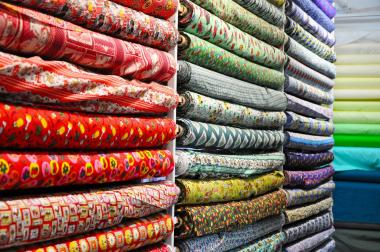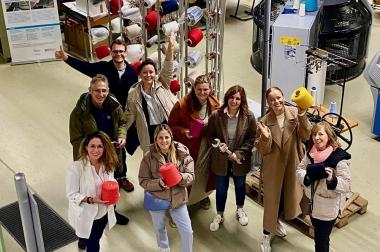100 Tage Bundesregierung: Südwesttextil zieht kritisch Bilanz
Umsatzrückgang und Beschäftigtenverlust prägen das erste Halbjahr der Textilindustrie in Baden-Württemberg. Nach 100 Tagen Bundesregierung stehen erste Schritte der Wirtschaftswende neuen Bürokratiebelastungen und einem nicht gegenfinanzierten Rentenpaket 2025 gegenüber. Südwesttextil fordert eine konsequente Entbürokratisierung des Arbeitsmarkts und ein klares Bekenntnis zu einer zukunftsfesten Sozialpolitik, die den demografischen Wandel und die Generationengerechtigkeit berücksichtigt.
Im ersten Halbjahr hat die baden-württembergische Textilindustrie einen Umsatzrückgang von 4,1 Prozent verzeichnet. Die Anzahl der Beschäftigten ist in der gesamten Branche im Vergleich zum Vorjahr um 2,4 Prozent gesunken. Der Wirtschafts- und Arbeitgeberverband Südwesttextil sieht den Wirtschaftsstandort unter großer Belastung durch Bürokratie, Strukturveränderungen und demografischen Wandel.
100 Tage Bundesregierung: Wirtschaftspolitische Konsequenz gefordert
In dieser Woche ist die schwarz-rote Bundesregierung seit 100 Tagen im Amt und sieht die Umsetzung der Wirtschaftswende eingeleitet. Südwesttextil bewertet positiv, dass zentrale Vorhaben aus dem Koalitionsvertrag, wie das steuerliche Investitionssofortprogramm, die Abschaffung der Gasspeicherumlage oder das neue Vergabebeschleunigungsgesetz, bereits umgesetzt wurden. Dies ist aber nicht ausreichend, um eine wirtschaftspolitische Trendwende einzuleiten, wenn gleichzeitig US-Zölle den Handel erschweren und Gesetzesvorhaben wie das Tariftreuegesetz und das Rentenpaket für neue Bürokratie und Belastungen sorgen.
Rentenpaket 2025: Südwesttextil kritisiert fehlende Gegenfinanzierung, Reformen und Generationengerechtigkeit
Das Rentenpaket wurden in der letzten Woche im Bundeskabinett mit drei zentralen Gesetzesvorhaben beschlossen. Aus Perspektive des Wirtschafts- und Arbeitgeberverbands Südwesttextil gehen sowohl die Mütterrente III als auch die Stabilisierung des Rentenniveaus auf 48 Prozent des jeweils geltenden Durchschnittslohns bis 2031 an der Realität vorbei. Südwesttextil-Hauptgeschäftsführerin Edina Brenner: „Diese Rentenpolitik entbehrt jeglicher Gegenfinanzierung und belastet jüngere Generationen mit einer enormen Hypothek. Wir benötigen dringend Reformen, die das Renten- und Sozialsystem zukunftssicher machen und dabei nicht ausblenden, dass Beitragszahlende einer immer größeren Gruppe von Leistungsbeziehenden gegenüberstehen.“ Mit der Entwicklung von Reformen erst ab dem nächsten Jahr zu beginnen, ist viel zu spät. Um das Rentensystem langfristig zu sichern und generationengerecht zu finanzieren, bedarf es vielfältiger Ansätze. Andere Länder in Europa zeigen bereits, wie eine Kombination aus progressiver Anpassung des Rentenalters an die Lebenserwartung, einer ergänzenden Kapitaldeckung durch Aktien und mehr privater Vorsorge funktionieren. Darüber hinaus ist entscheidend, dass die Anreize für Arbeit über das gesetzliche Renteneintrittsalter hinaus erhöht werden.
Forderung nach Reformen: Bürokratieabbau und attraktive Beschäftigung als Schlüssel zur Zukunft
Die Aufhebung des Anschlussverbots bei sachgrundlosen Befristungen für Personen, die die Regelaltersgrenze bereits erreicht bzw. überschritten haben, begrüßt Südwesttextil dagegen ausdrücklich. Dies hatte bisher die freiwillige Weiterarbeit nach Renteneintritt deutlich erschwert.
Aus Perspektive des Wirtschafts- und Arbeitgeberverbands Südwesttextil gelte es vielfältige Stellschrauben zu bewegen: „Um Wirtschaftskrise und demografischen Wandel zu bewältigen, bedarf es der Entbürokratisierung im Bereich von Beschäftigung und der Mobilisierung von Potenzialen. Dazu zählt die Verlängerung der Lebensarbeitszeit ebenso wie die erleichterte Zuwanderung von Fachkräften aus Drittstaaten. Nach wie vor muss der vollständige Zugang zum deutschen Arbeitsmarkt deutlich beschleunigt und digitalisiert werden.“
Auch den Sozialversicherungsbeiträgen droht in den nächsten Jahren ein starker Anstieg. Eine Prognose des IGES Institut berechnet selbst bei einem Basis-Szenario einen Anstieg des Gesamtsozialversicherungsbeitrags auf 48,6 Prozent des Bruttolohns für 2035. Damit sinkt die Attraktivität des deutschen Arbeitsmarktes im Verhältnis zu europäischen Nachbarländern nicht nur aus Arbeitgeber-, sondern gerade auch aus Arbeitnehmersicht. Die Sozialabgaben müssen daher dringend begrenzt und langfristig unter 40 Prozent gesenkt werden.
Baden-Württemberg Verband der Südwestdeutschen Textil- und Bekleidungsindustrie Südwesttextil e.V. Südwesttextil Bundesregierung Rente Bürokratieabbau Sozialabgaben
Verband der Südwestdeutschen Textil- und Bekleidungsindustrie Südwesttextil































